Talent Management Importance: Crafting Employee Retention at Unilever
VerifiedAdded on 2023/06/12
|11
|3883
|70
Literature Review
AI Summary
This literature review explores the concept of talent management and its importance in crafting employee retention, particularly within the retail sector, using Unilever as a case study. It delves into the role of leaders in employee well-being and the best talent management strategies for enhancing business performance. The review covers themes such as the fundamental concept of talent management, highlighting recruitment and performance management as key elements, and discusses the practices that are most effective for retaining employees, emphasizing the importance of training and motivation. Furthermore, it examines the crucial role of leadership in fostering employee well-being, promoting a healthy and productive work environment, and driving profitability through motivated and engaged employees. The review synthesizes various perspectives, noting the necessity of balancing employee focus with innovation and the importance of continuous development and fair leadership in achieving organizational success. Desklib provides access to this and other solved assignments for students.
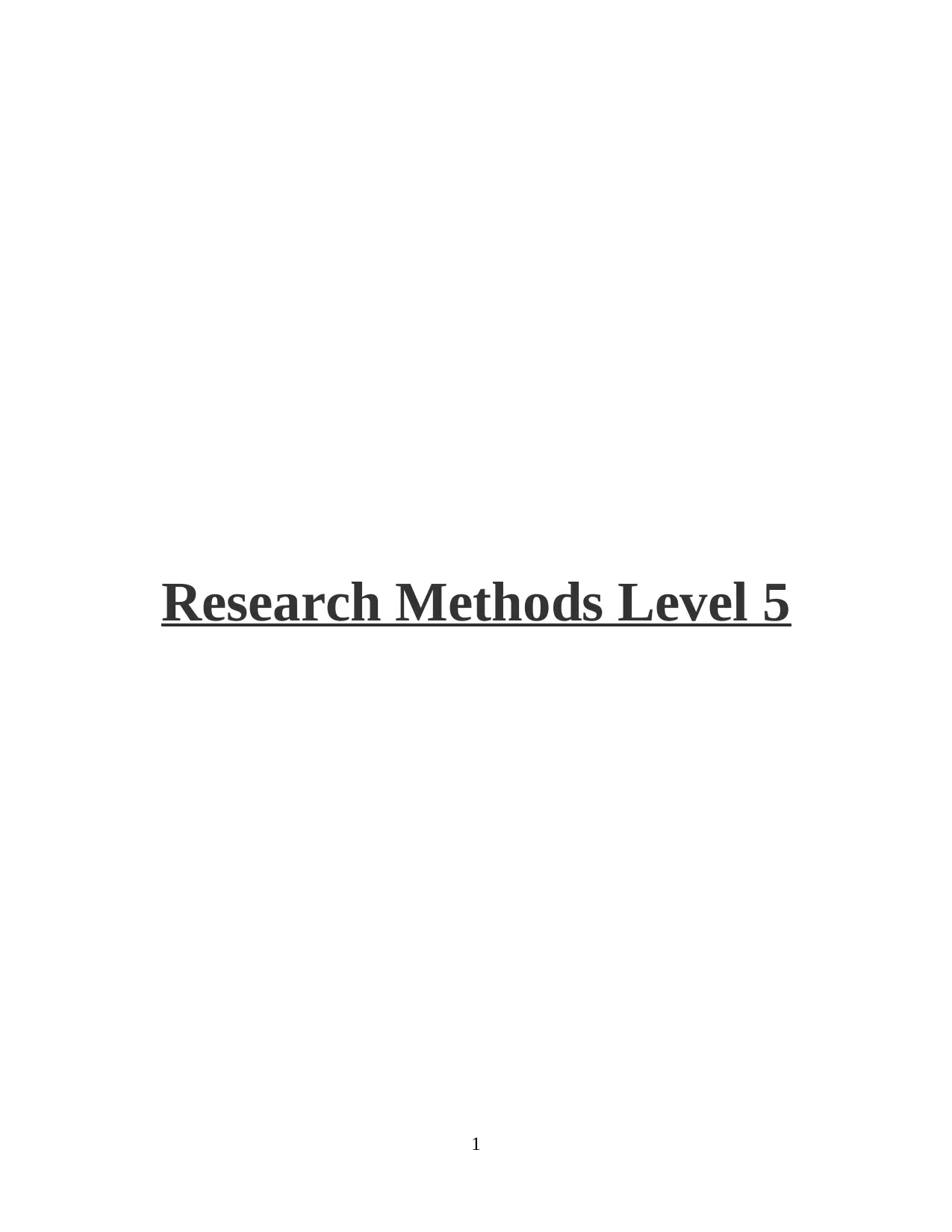
Research Methods Level 5
1
1
Paraphrase This Document
Need a fresh take? Get an instant paraphrase of this document with our AI Paraphraser
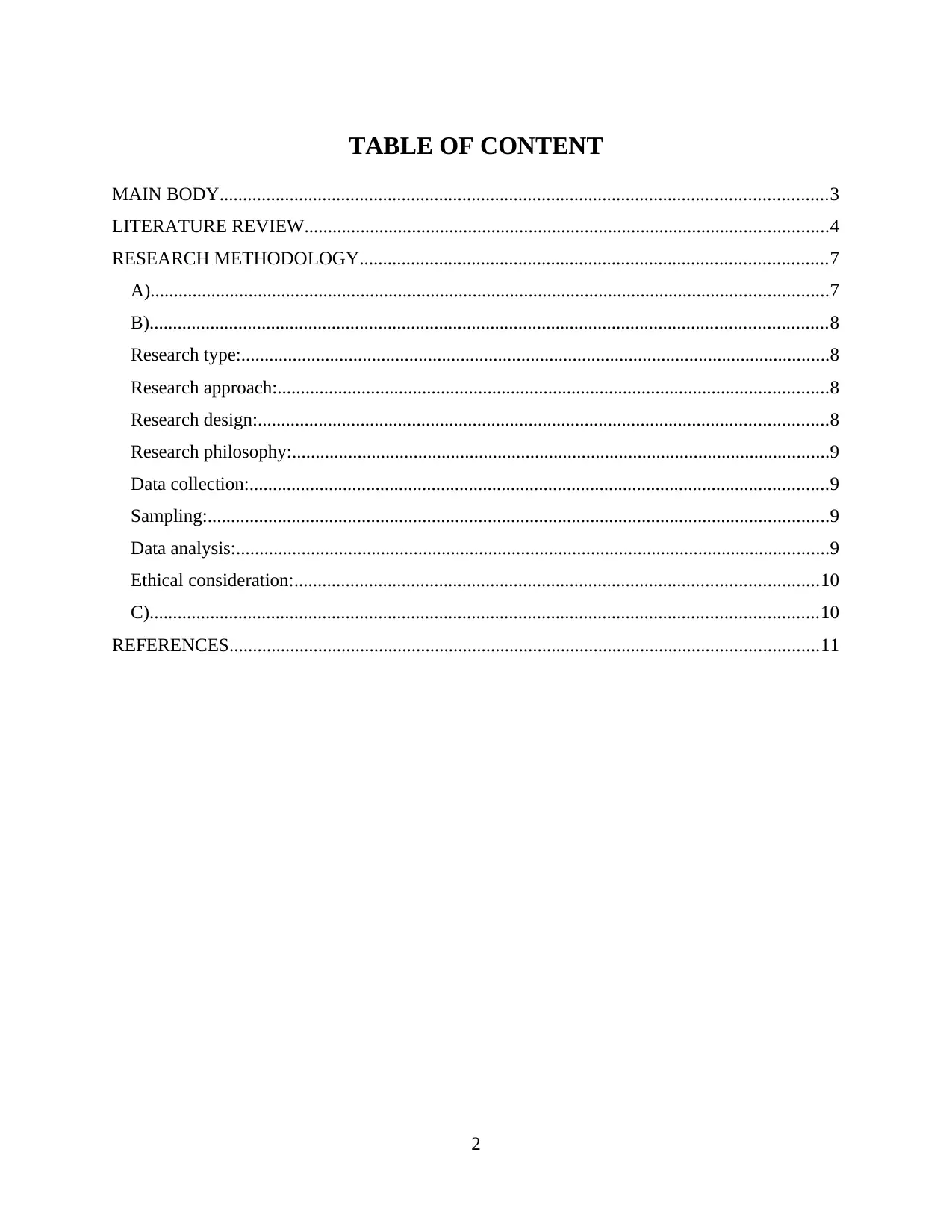
TABLE OF CONTENT
MAIN BODY..................................................................................................................................3
LITERATURE REVIEW................................................................................................................4
RESEARCH METHODOLOGY....................................................................................................7
A).................................................................................................................................................7
B).................................................................................................................................................8
Research type:..............................................................................................................................8
Research approach:......................................................................................................................8
Research design:..........................................................................................................................8
Research philosophy:...................................................................................................................9
Data collection:............................................................................................................................9
Sampling:.....................................................................................................................................9
Data analysis:...............................................................................................................................9
Ethical consideration:................................................................................................................10
C)...............................................................................................................................................10
REFERENCES..............................................................................................................................11
2
MAIN BODY..................................................................................................................................3
LITERATURE REVIEW................................................................................................................4
RESEARCH METHODOLOGY....................................................................................................7
A).................................................................................................................................................7
B).................................................................................................................................................8
Research type:..............................................................................................................................8
Research approach:......................................................................................................................8
Research design:..........................................................................................................................8
Research philosophy:...................................................................................................................9
Data collection:............................................................................................................................9
Sampling:.....................................................................................................................................9
Data analysis:...............................................................................................................................9
Ethical consideration:................................................................................................................10
C)...............................................................................................................................................10
REFERENCES..............................................................................................................................11
2
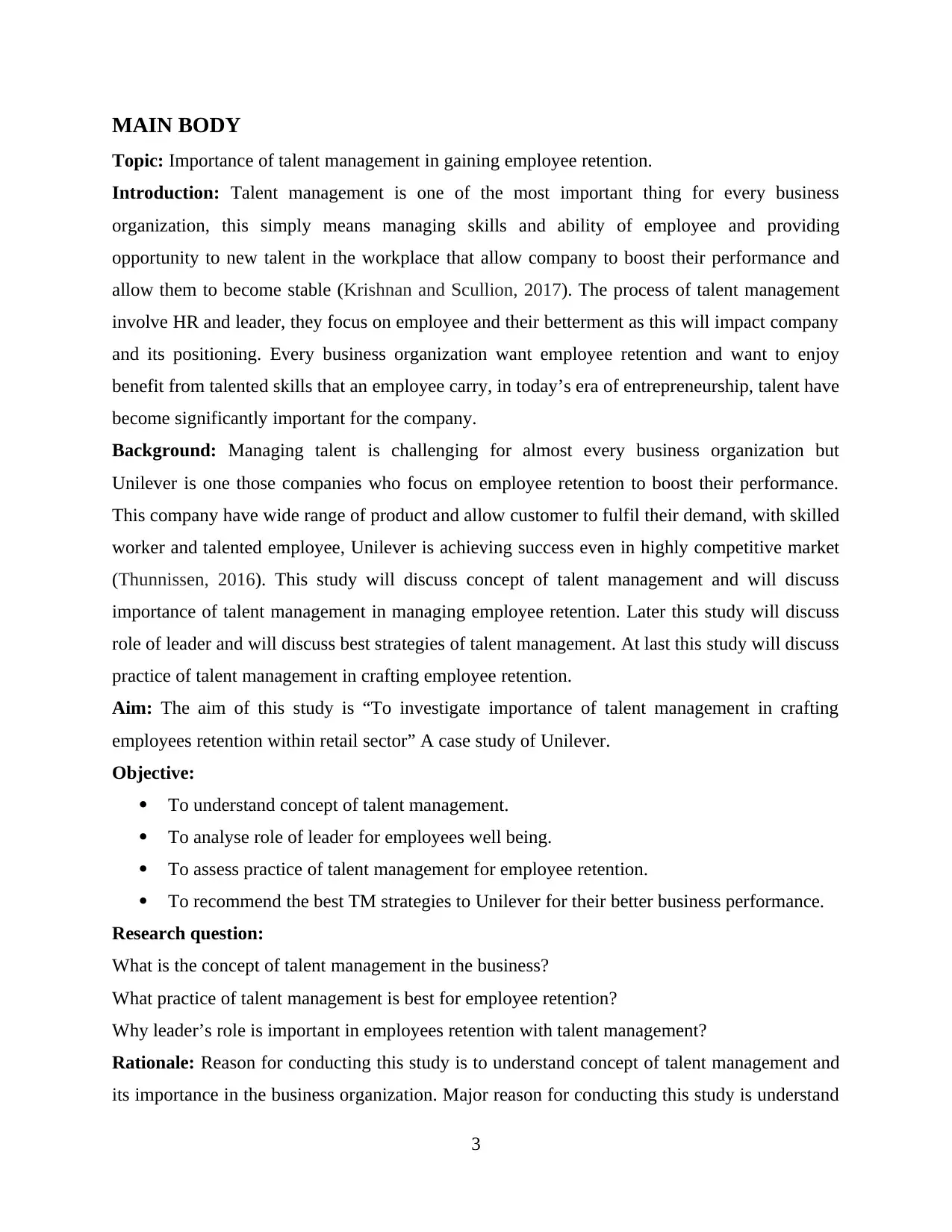
MAIN BODY
Topic: Importance of talent management in gaining employee retention.
Introduction: Talent management is one of the most important thing for every business
organization, this simply means managing skills and ability of employee and providing
opportunity to new talent in the workplace that allow company to boost their performance and
allow them to become stable (Krishnan and Scullion, 2017). The process of talent management
involve HR and leader, they focus on employee and their betterment as this will impact company
and its positioning. Every business organization want employee retention and want to enjoy
benefit from talented skills that an employee carry, in today’s era of entrepreneurship, talent have
become significantly important for the company.
Background: Managing talent is challenging for almost every business organization but
Unilever is one those companies who focus on employee retention to boost their performance.
This company have wide range of product and allow customer to fulfil their demand, with skilled
worker and talented employee, Unilever is achieving success even in highly competitive market
(Thunnissen, 2016). This study will discuss concept of talent management and will discuss
importance of talent management in managing employee retention. Later this study will discuss
role of leader and will discuss best strategies of talent management. At last this study will discuss
practice of talent management in crafting employee retention.
Aim: The aim of this study is “To investigate importance of talent management in crafting
employees retention within retail sector” A case study of Unilever.
Objective:
To understand concept of talent management.
To analyse role of leader for employees well being.
To assess practice of talent management for employee retention.
To recommend the best TM strategies to Unilever for their better business performance.
Research question:
What is the concept of talent management in the business?
What practice of talent management is best for employee retention?
Why leader’s role is important in employees retention with talent management?
Rationale: Reason for conducting this study is to understand concept of talent management and
its importance in the business organization. Major reason for conducting this study is understand
3
Topic: Importance of talent management in gaining employee retention.
Introduction: Talent management is one of the most important thing for every business
organization, this simply means managing skills and ability of employee and providing
opportunity to new talent in the workplace that allow company to boost their performance and
allow them to become stable (Krishnan and Scullion, 2017). The process of talent management
involve HR and leader, they focus on employee and their betterment as this will impact company
and its positioning. Every business organization want employee retention and want to enjoy
benefit from talented skills that an employee carry, in today’s era of entrepreneurship, talent have
become significantly important for the company.
Background: Managing talent is challenging for almost every business organization but
Unilever is one those companies who focus on employee retention to boost their performance.
This company have wide range of product and allow customer to fulfil their demand, with skilled
worker and talented employee, Unilever is achieving success even in highly competitive market
(Thunnissen, 2016). This study will discuss concept of talent management and will discuss
importance of talent management in managing employee retention. Later this study will discuss
role of leader and will discuss best strategies of talent management. At last this study will discuss
practice of talent management in crafting employee retention.
Aim: The aim of this study is “To investigate importance of talent management in crafting
employees retention within retail sector” A case study of Unilever.
Objective:
To understand concept of talent management.
To analyse role of leader for employees well being.
To assess practice of talent management for employee retention.
To recommend the best TM strategies to Unilever for their better business performance.
Research question:
What is the concept of talent management in the business?
What practice of talent management is best for employee retention?
Why leader’s role is important in employees retention with talent management?
Rationale: Reason for conducting this study is to understand concept of talent management and
its importance in the business organization. Major reason for conducting this study is understand
3
⊘ This is a preview!⊘
Do you want full access?
Subscribe today to unlock all pages.

Trusted by 1+ million students worldwide
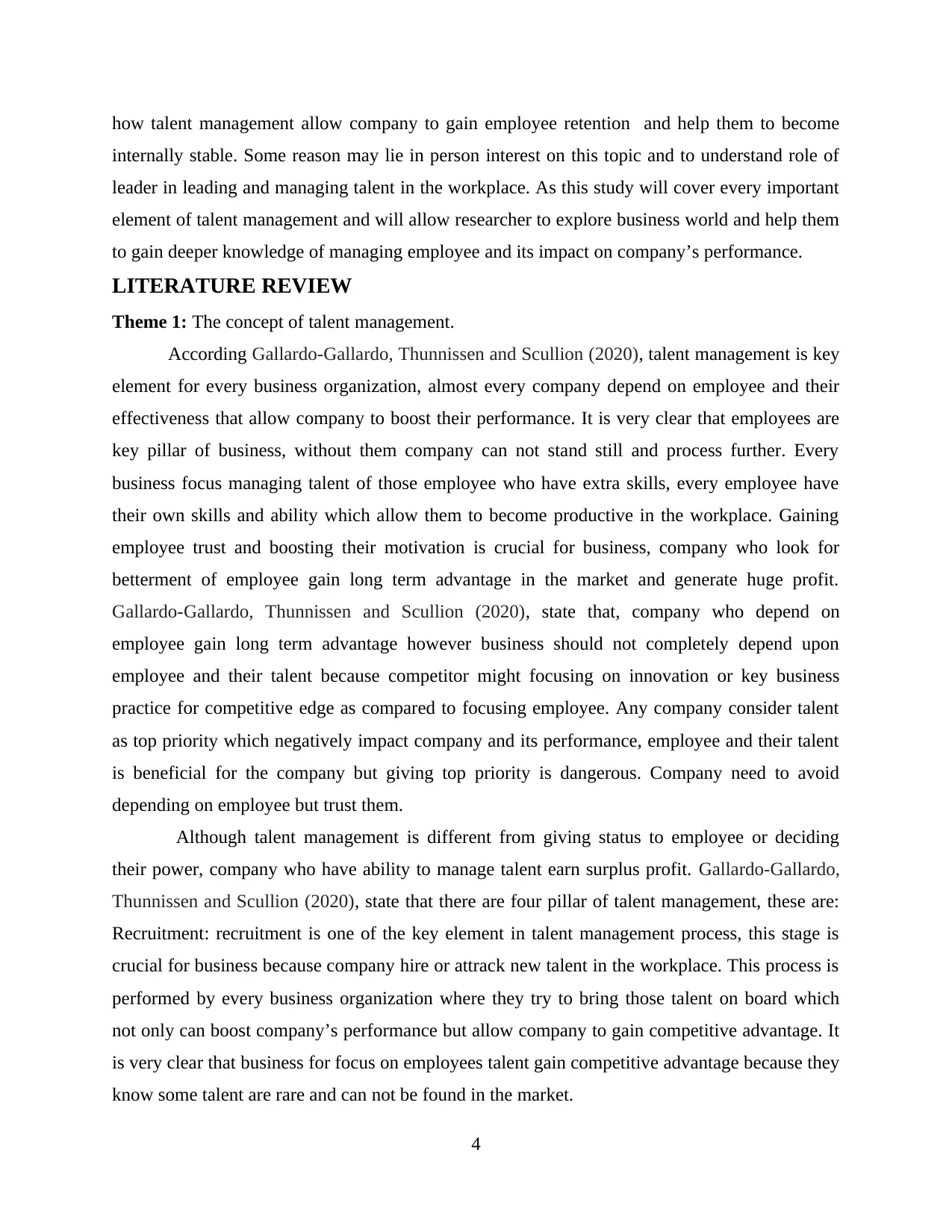
how talent management allow company to gain employee retention and help them to become
internally stable. Some reason may lie in person interest on this topic and to understand role of
leader in leading and managing talent in the workplace. As this study will cover every important
element of talent management and will allow researcher to explore business world and help them
to gain deeper knowledge of managing employee and its impact on company’s performance.
LITERATURE REVIEW
Theme 1: The concept of talent management.
According Gallardo-Gallardo, Thunnissen and Scullion (2020), talent management is key
element for every business organization, almost every company depend on employee and their
effectiveness that allow company to boost their performance. It is very clear that employees are
key pillar of business, without them company can not stand still and process further. Every
business focus managing talent of those employee who have extra skills, every employee have
their own skills and ability which allow them to become productive in the workplace. Gaining
employee trust and boosting their motivation is crucial for business, company who look for
betterment of employee gain long term advantage in the market and generate huge profit.
Gallardo-Gallardo, Thunnissen and Scullion (2020), state that, company who depend on
employee gain long term advantage however business should not completely depend upon
employee and their talent because competitor might focusing on innovation or key business
practice for competitive edge as compared to focusing employee. Any company consider talent
as top priority which negatively impact company and its performance, employee and their talent
is beneficial for the company but giving top priority is dangerous. Company need to avoid
depending on employee but trust them.
Although talent management is different from giving status to employee or deciding
their power, company who have ability to manage talent earn surplus profit. Gallardo-Gallardo,
Thunnissen and Scullion (2020), state that there are four pillar of talent management, these are:
Recruitment: recruitment is one of the key element in talent management process, this stage is
crucial for business because company hire or attrack new talent in the workplace. This process is
performed by every business organization where they try to bring those talent on board which
not only can boost company’s performance but allow company to gain competitive advantage. It
is very clear that business for focus on employees talent gain competitive advantage because they
know some talent are rare and can not be found in the market.
4
internally stable. Some reason may lie in person interest on this topic and to understand role of
leader in leading and managing talent in the workplace. As this study will cover every important
element of talent management and will allow researcher to explore business world and help them
to gain deeper knowledge of managing employee and its impact on company’s performance.
LITERATURE REVIEW
Theme 1: The concept of talent management.
According Gallardo-Gallardo, Thunnissen and Scullion (2020), talent management is key
element for every business organization, almost every company depend on employee and their
effectiveness that allow company to boost their performance. It is very clear that employees are
key pillar of business, without them company can not stand still and process further. Every
business focus managing talent of those employee who have extra skills, every employee have
their own skills and ability which allow them to become productive in the workplace. Gaining
employee trust and boosting their motivation is crucial for business, company who look for
betterment of employee gain long term advantage in the market and generate huge profit.
Gallardo-Gallardo, Thunnissen and Scullion (2020), state that, company who depend on
employee gain long term advantage however business should not completely depend upon
employee and their talent because competitor might focusing on innovation or key business
practice for competitive edge as compared to focusing employee. Any company consider talent
as top priority which negatively impact company and its performance, employee and their talent
is beneficial for the company but giving top priority is dangerous. Company need to avoid
depending on employee but trust them.
Although talent management is different from giving status to employee or deciding
their power, company who have ability to manage talent earn surplus profit. Gallardo-Gallardo,
Thunnissen and Scullion (2020), state that there are four pillar of talent management, these are:
Recruitment: recruitment is one of the key element in talent management process, this stage is
crucial for business because company hire or attrack new talent in the workplace. This process is
performed by every business organization where they try to bring those talent on board which
not only can boost company’s performance but allow company to gain competitive advantage. It
is very clear that business for focus on employees talent gain competitive advantage because they
know some talent are rare and can not be found in the market.
4
Paraphrase This Document
Need a fresh take? Get an instant paraphrase of this document with our AI Paraphraser
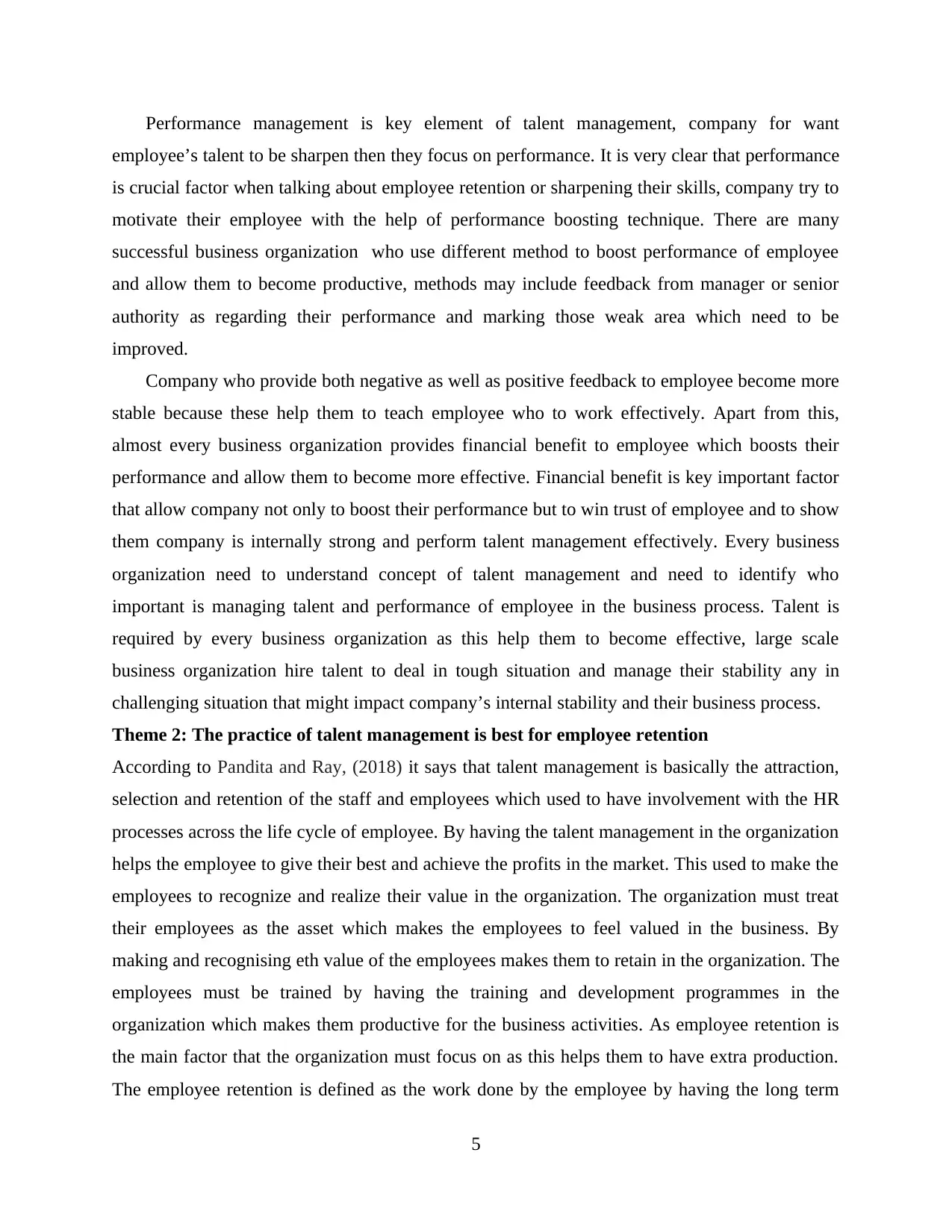
Performance management is key element of talent management, company for want
employee’s talent to be sharpen then they focus on performance. It is very clear that performance
is crucial factor when talking about employee retention or sharpening their skills, company try to
motivate their employee with the help of performance boosting technique. There are many
successful business organization who use different method to boost performance of employee
and allow them to become productive, methods may include feedback from manager or senior
authority as regarding their performance and marking those weak area which need to be
improved.
Company who provide both negative as well as positive feedback to employee become more
stable because these help them to teach employee who to work effectively. Apart from this,
almost every business organization provides financial benefit to employee which boosts their
performance and allow them to become more effective. Financial benefit is key important factor
that allow company not only to boost their performance but to win trust of employee and to show
them company is internally strong and perform talent management effectively. Every business
organization need to understand concept of talent management and need to identify who
important is managing talent and performance of employee in the business process. Talent is
required by every business organization as this help them to become effective, large scale
business organization hire talent to deal in tough situation and manage their stability any in
challenging situation that might impact company’s internal stability and their business process.
Theme 2: The practice of talent management is best for employee retention
According to Pandita and Ray, (2018) it says that talent management is basically the attraction,
selection and retention of the staff and employees which used to have involvement with the HR
processes across the life cycle of employee. By having the talent management in the organization
helps the employee to give their best and achieve the profits in the market. This used to make the
employees to recognize and realize their value in the organization. The organization must treat
their employees as the asset which makes the employees to feel valued in the business. By
making and recognising eth value of the employees makes them to retain in the organization. The
employees must be trained by having the training and development programmes in the
organization which makes them productive for the business activities. As employee retention is
the main factor that the organization must focus on as this helps them to have extra production.
The employee retention is defined as the work done by the employee by having the long term
5
employee’s talent to be sharpen then they focus on performance. It is very clear that performance
is crucial factor when talking about employee retention or sharpening their skills, company try to
motivate their employee with the help of performance boosting technique. There are many
successful business organization who use different method to boost performance of employee
and allow them to become productive, methods may include feedback from manager or senior
authority as regarding their performance and marking those weak area which need to be
improved.
Company who provide both negative as well as positive feedback to employee become more
stable because these help them to teach employee who to work effectively. Apart from this,
almost every business organization provides financial benefit to employee which boosts their
performance and allow them to become more effective. Financial benefit is key important factor
that allow company not only to boost their performance but to win trust of employee and to show
them company is internally strong and perform talent management effectively. Every business
organization need to understand concept of talent management and need to identify who
important is managing talent and performance of employee in the business process. Talent is
required by every business organization as this help them to become effective, large scale
business organization hire talent to deal in tough situation and manage their stability any in
challenging situation that might impact company’s internal stability and their business process.
Theme 2: The practice of talent management is best for employee retention
According to Pandita and Ray, (2018) it says that talent management is basically the attraction,
selection and retention of the staff and employees which used to have involvement with the HR
processes across the life cycle of employee. By having the talent management in the organization
helps the employee to give their best and achieve the profits in the market. This used to make the
employees to recognize and realize their value in the organization. The organization must treat
their employees as the asset which makes the employees to feel valued in the business. By
making and recognising eth value of the employees makes them to retain in the organization. The
employees must be trained by having the training and development programmes in the
organization which makes them productive for the business activities. As employee retention is
the main factor that the organization must focus on as this helps them to have extra production.
The employee retention is defined as the work done by the employee by having the long term
5
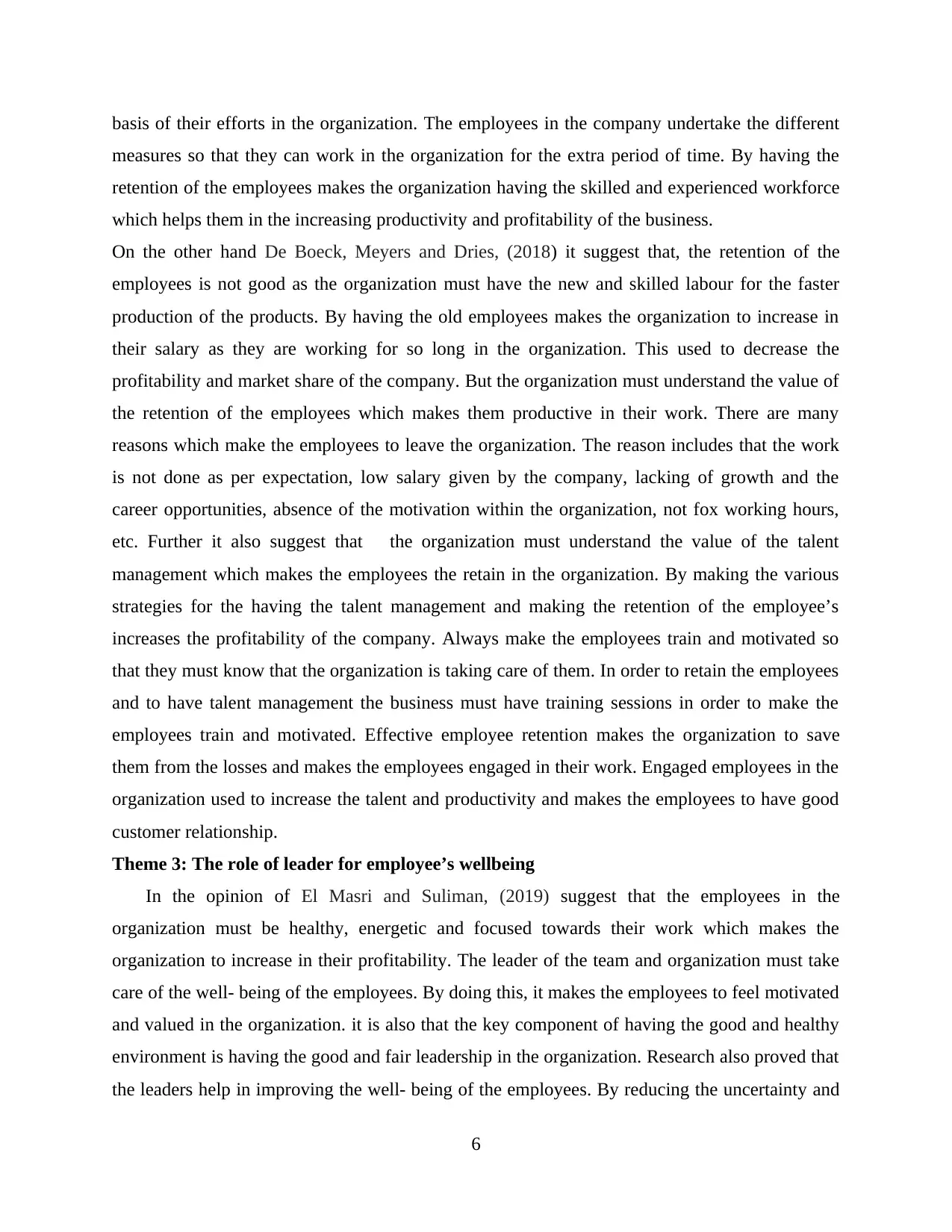
basis of their efforts in the organization. The employees in the company undertake the different
measures so that they can work in the organization for the extra period of time. By having the
retention of the employees makes the organization having the skilled and experienced workforce
which helps them in the increasing productivity and profitability of the business.
On the other hand De Boeck, Meyers and Dries, (2018) it suggest that, the retention of the
employees is not good as the organization must have the new and skilled labour for the faster
production of the products. By having the old employees makes the organization to increase in
their salary as they are working for so long in the organization. This used to decrease the
profitability and market share of the company. But the organization must understand the value of
the retention of the employees which makes them productive in their work. There are many
reasons which make the employees to leave the organization. The reason includes that the work
is not done as per expectation, low salary given by the company, lacking of growth and the
career opportunities, absence of the motivation within the organization, not fox working hours,
etc. Further it also suggest that the organization must understand the value of the talent
management which makes the employees the retain in the organization. By making the various
strategies for the having the talent management and making the retention of the employee’s
increases the profitability of the company. Always make the employees train and motivated so
that they must know that the organization is taking care of them. In order to retain the employees
and to have talent management the business must have training sessions in order to make the
employees train and motivated. Effective employee retention makes the organization to save
them from the losses and makes the employees engaged in their work. Engaged employees in the
organization used to increase the talent and productivity and makes the employees to have good
customer relationship.
Theme 3: The role of leader for employee’s wellbeing
In the opinion of El Masri and Suliman, (2019) suggest that the employees in the
organization must be healthy, energetic and focused towards their work which makes the
organization to increase in their profitability. The leader of the team and organization must take
care of the well- being of the employees. By doing this, it makes the employees to feel motivated
and valued in the organization. it is also that the key component of having the good and healthy
environment is having the good and fair leadership in the organization. Research also proved that
the leaders help in improving the well- being of the employees. By reducing the uncertainty and
6
measures so that they can work in the organization for the extra period of time. By having the
retention of the employees makes the organization having the skilled and experienced workforce
which helps them in the increasing productivity and profitability of the business.
On the other hand De Boeck, Meyers and Dries, (2018) it suggest that, the retention of the
employees is not good as the organization must have the new and skilled labour for the faster
production of the products. By having the old employees makes the organization to increase in
their salary as they are working for so long in the organization. This used to decrease the
profitability and market share of the company. But the organization must understand the value of
the retention of the employees which makes them productive in their work. There are many
reasons which make the employees to leave the organization. The reason includes that the work
is not done as per expectation, low salary given by the company, lacking of growth and the
career opportunities, absence of the motivation within the organization, not fox working hours,
etc. Further it also suggest that the organization must understand the value of the talent
management which makes the employees the retain in the organization. By making the various
strategies for the having the talent management and making the retention of the employee’s
increases the profitability of the company. Always make the employees train and motivated so
that they must know that the organization is taking care of them. In order to retain the employees
and to have talent management the business must have training sessions in order to make the
employees train and motivated. Effective employee retention makes the organization to save
them from the losses and makes the employees engaged in their work. Engaged employees in the
organization used to increase the talent and productivity and makes the employees to have good
customer relationship.
Theme 3: The role of leader for employee’s wellbeing
In the opinion of El Masri and Suliman, (2019) suggest that the employees in the
organization must be healthy, energetic and focused towards their work which makes the
organization to increase in their profitability. The leader of the team and organization must take
care of the well- being of the employees. By doing this, it makes the employees to feel motivated
and valued in the organization. it is also that the key component of having the good and healthy
environment is having the good and fair leadership in the organization. Research also proved that
the leaders help in improving the well- being of the employees. By reducing the uncertainty and
6
⊘ This is a preview!⊘
Do you want full access?
Subscribe today to unlock all pages.

Trusted by 1+ million students worldwide
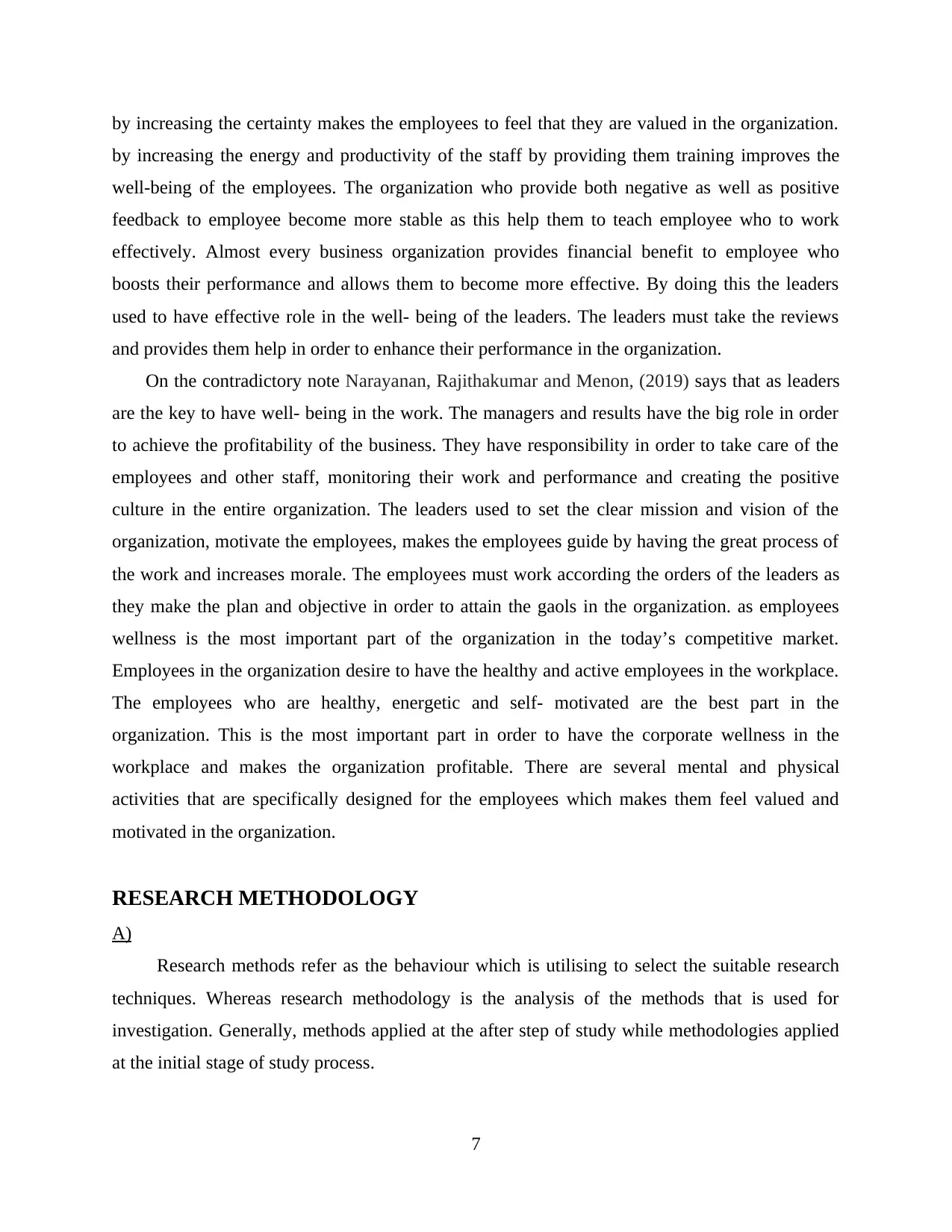
by increasing the certainty makes the employees to feel that they are valued in the organization.
by increasing the energy and productivity of the staff by providing them training improves the
well-being of the employees. The organization who provide both negative as well as positive
feedback to employee become more stable as this help them to teach employee who to work
effectively. Almost every business organization provides financial benefit to employee who
boosts their performance and allows them to become more effective. By doing this the leaders
used to have effective role in the well- being of the leaders. The leaders must take the reviews
and provides them help in order to enhance their performance in the organization.
On the contradictory note Narayanan, Rajithakumar and Menon, (2019) says that as leaders
are the key to have well- being in the work. The managers and results have the big role in order
to achieve the profitability of the business. They have responsibility in order to take care of the
employees and other staff, monitoring their work and performance and creating the positive
culture in the entire organization. The leaders used to set the clear mission and vision of the
organization, motivate the employees, makes the employees guide by having the great process of
the work and increases morale. The employees must work according the orders of the leaders as
they make the plan and objective in order to attain the gaols in the organization. as employees
wellness is the most important part of the organization in the today’s competitive market.
Employees in the organization desire to have the healthy and active employees in the workplace.
The employees who are healthy, energetic and self- motivated are the best part in the
organization. This is the most important part in order to have the corporate wellness in the
workplace and makes the organization profitable. There are several mental and physical
activities that are specifically designed for the employees which makes them feel valued and
motivated in the organization.
RESEARCH METHODOLOGY
A)
Research methods refer as the behaviour which is utilising to select the suitable research
techniques. Whereas research methodology is the analysis of the methods that is used for
investigation. Generally, methods applied at the after step of study while methodologies applied
at the initial stage of study process.
7
by increasing the energy and productivity of the staff by providing them training improves the
well-being of the employees. The organization who provide both negative as well as positive
feedback to employee become more stable as this help them to teach employee who to work
effectively. Almost every business organization provides financial benefit to employee who
boosts their performance and allows them to become more effective. By doing this the leaders
used to have effective role in the well- being of the leaders. The leaders must take the reviews
and provides them help in order to enhance their performance in the organization.
On the contradictory note Narayanan, Rajithakumar and Menon, (2019) says that as leaders
are the key to have well- being in the work. The managers and results have the big role in order
to achieve the profitability of the business. They have responsibility in order to take care of the
employees and other staff, monitoring their work and performance and creating the positive
culture in the entire organization. The leaders used to set the clear mission and vision of the
organization, motivate the employees, makes the employees guide by having the great process of
the work and increases morale. The employees must work according the orders of the leaders as
they make the plan and objective in order to attain the gaols in the organization. as employees
wellness is the most important part of the organization in the today’s competitive market.
Employees in the organization desire to have the healthy and active employees in the workplace.
The employees who are healthy, energetic and self- motivated are the best part in the
organization. This is the most important part in order to have the corporate wellness in the
workplace and makes the organization profitable. There are several mental and physical
activities that are specifically designed for the employees which makes them feel valued and
motivated in the organization.
RESEARCH METHODOLOGY
A)
Research methods refer as the behaviour which is utilising to select the suitable research
techniques. Whereas research methodology is the analysis of the methods that is used for
investigation. Generally, methods applied at the after step of study while methodologies applied
at the initial stage of study process.
7
Paraphrase This Document
Need a fresh take? Get an instant paraphrase of this document with our AI Paraphraser
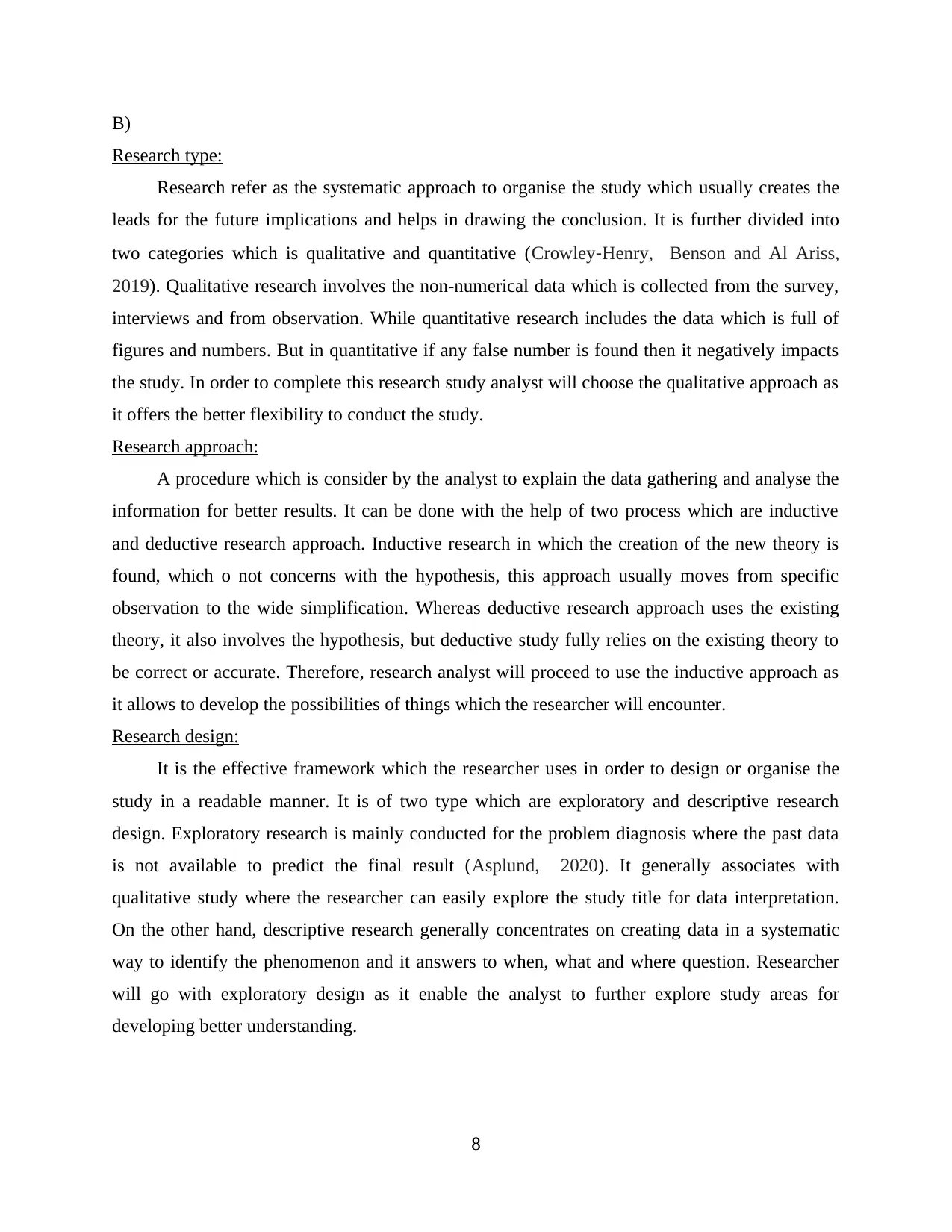
B)
Research type:
Research refer as the systematic approach to organise the study which usually creates the
leads for the future implications and helps in drawing the conclusion. It is further divided into
two categories which is qualitative and quantitative (Crowley‐Henry, Benson and Al Ariss,
2019). Qualitative research involves the non-numerical data which is collected from the survey,
interviews and from observation. While quantitative research includes the data which is full of
figures and numbers. But in quantitative if any false number is found then it negatively impacts
the study. In order to complete this research study analyst will choose the qualitative approach as
it offers the better flexibility to conduct the study.
Research approach:
A procedure which is consider by the analyst to explain the data gathering and analyse the
information for better results. It can be done with the help of two process which are inductive
and deductive research approach. Inductive research in which the creation of the new theory is
found, which o not concerns with the hypothesis, this approach usually moves from specific
observation to the wide simplification. Whereas deductive research approach uses the existing
theory, it also involves the hypothesis, but deductive study fully relies on the existing theory to
be correct or accurate. Therefore, research analyst will proceed to use the inductive approach as
it allows to develop the possibilities of things which the researcher will encounter.
Research design:
It is the effective framework which the researcher uses in order to design or organise the
study in a readable manner. It is of two type which are exploratory and descriptive research
design. Exploratory research is mainly conducted for the problem diagnosis where the past data
is not available to predict the final result (Asplund, 2020). It generally associates with
qualitative study where the researcher can easily explore the study title for data interpretation.
On the other hand, descriptive research generally concentrates on creating data in a systematic
way to identify the phenomenon and it answers to when, what and where question. Researcher
will go with exploratory design as it enable the analyst to further explore study areas for
developing better understanding.
8
Research type:
Research refer as the systematic approach to organise the study which usually creates the
leads for the future implications and helps in drawing the conclusion. It is further divided into
two categories which is qualitative and quantitative (Crowley‐Henry, Benson and Al Ariss,
2019). Qualitative research involves the non-numerical data which is collected from the survey,
interviews and from observation. While quantitative research includes the data which is full of
figures and numbers. But in quantitative if any false number is found then it negatively impacts
the study. In order to complete this research study analyst will choose the qualitative approach as
it offers the better flexibility to conduct the study.
Research approach:
A procedure which is consider by the analyst to explain the data gathering and analyse the
information for better results. It can be done with the help of two process which are inductive
and deductive research approach. Inductive research in which the creation of the new theory is
found, which o not concerns with the hypothesis, this approach usually moves from specific
observation to the wide simplification. Whereas deductive research approach uses the existing
theory, it also involves the hypothesis, but deductive study fully relies on the existing theory to
be correct or accurate. Therefore, research analyst will proceed to use the inductive approach as
it allows to develop the possibilities of things which the researcher will encounter.
Research design:
It is the effective framework which the researcher uses in order to design or organise the
study in a readable manner. It is of two type which are exploratory and descriptive research
design. Exploratory research is mainly conducted for the problem diagnosis where the past data
is not available to predict the final result (Asplund, 2020). It generally associates with
qualitative study where the researcher can easily explore the study title for data interpretation.
On the other hand, descriptive research generally concentrates on creating data in a systematic
way to identify the phenomenon and it answers to when, what and where question. Researcher
will go with exploratory design as it enable the analyst to further explore study areas for
developing better understanding.
8
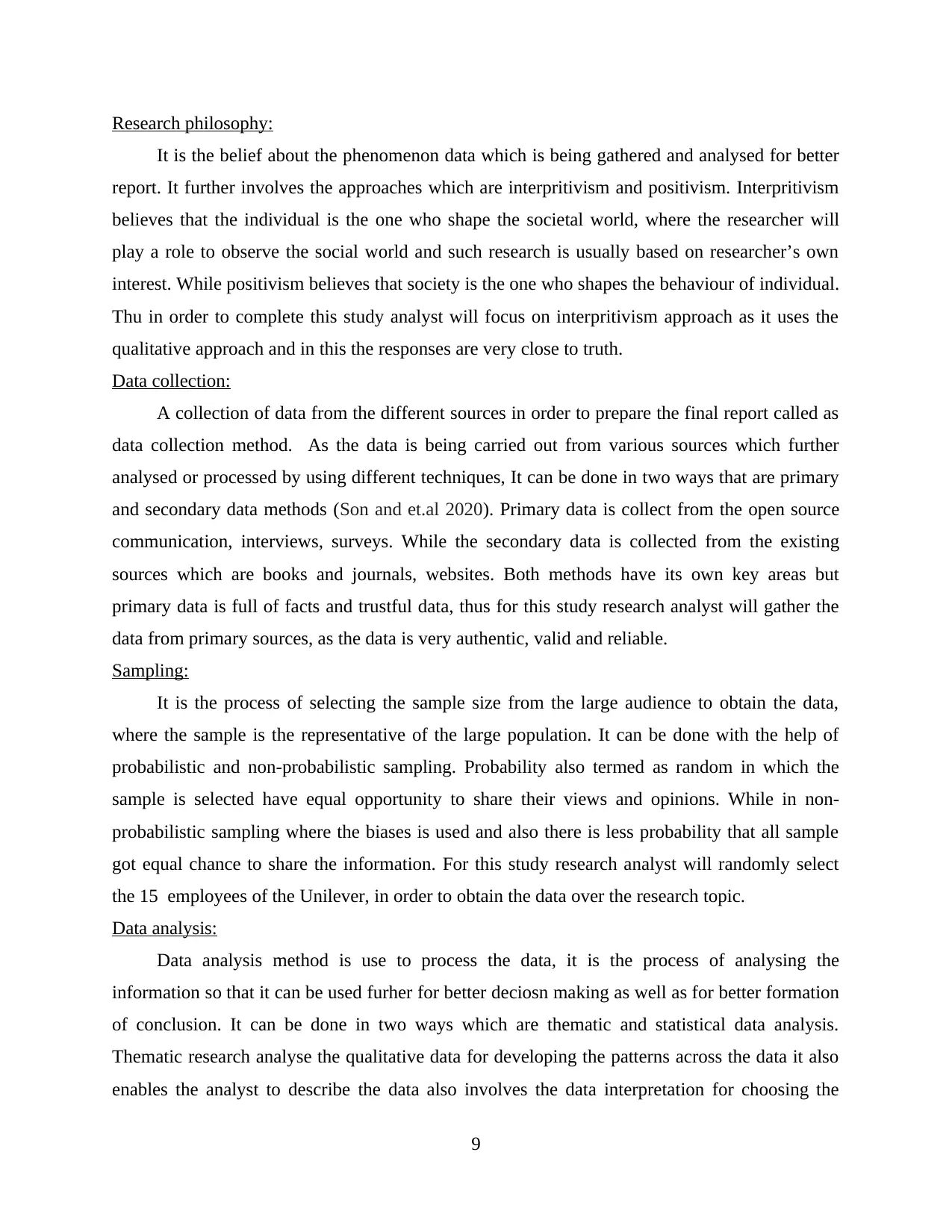
Research philosophy:
It is the belief about the phenomenon data which is being gathered and analysed for better
report. It further involves the approaches which are interpritivism and positivism. Interpritivism
believes that the individual is the one who shape the societal world, where the researcher will
play a role to observe the social world and such research is usually based on researcher’s own
interest. While positivism believes that society is the one who shapes the behaviour of individual.
Thu in order to complete this study analyst will focus on interpritivism approach as it uses the
qualitative approach and in this the responses are very close to truth.
Data collection:
A collection of data from the different sources in order to prepare the final report called as
data collection method. As the data is being carried out from various sources which further
analysed or processed by using different techniques, It can be done in two ways that are primary
and secondary data methods (Son and et.al 2020). Primary data is collect from the open source
communication, interviews, surveys. While the secondary data is collected from the existing
sources which are books and journals, websites. Both methods have its own key areas but
primary data is full of facts and trustful data, thus for this study research analyst will gather the
data from primary sources, as the data is very authentic, valid and reliable.
Sampling:
It is the process of selecting the sample size from the large audience to obtain the data,
where the sample is the representative of the large population. It can be done with the help of
probabilistic and non-probabilistic sampling. Probability also termed as random in which the
sample is selected have equal opportunity to share their views and opinions. While in non-
probabilistic sampling where the biases is used and also there is less probability that all sample
got equal chance to share the information. For this study research analyst will randomly select
the 15 employees of the Unilever, in order to obtain the data over the research topic.
Data analysis:
Data analysis method is use to process the data, it is the process of analysing the
information so that it can be used furher for better deciosn making as well as for better formation
of conclusion. It can be done in two ways which are thematic and statistical data analysis.
Thematic research analyse the qualitative data for developing the patterns across the data it also
enables the analyst to describe the data also involves the data interpretation for choosing the
9
It is the belief about the phenomenon data which is being gathered and analysed for better
report. It further involves the approaches which are interpritivism and positivism. Interpritivism
believes that the individual is the one who shape the societal world, where the researcher will
play a role to observe the social world and such research is usually based on researcher’s own
interest. While positivism believes that society is the one who shapes the behaviour of individual.
Thu in order to complete this study analyst will focus on interpritivism approach as it uses the
qualitative approach and in this the responses are very close to truth.
Data collection:
A collection of data from the different sources in order to prepare the final report called as
data collection method. As the data is being carried out from various sources which further
analysed or processed by using different techniques, It can be done in two ways that are primary
and secondary data methods (Son and et.al 2020). Primary data is collect from the open source
communication, interviews, surveys. While the secondary data is collected from the existing
sources which are books and journals, websites. Both methods have its own key areas but
primary data is full of facts and trustful data, thus for this study research analyst will gather the
data from primary sources, as the data is very authentic, valid and reliable.
Sampling:
It is the process of selecting the sample size from the large audience to obtain the data,
where the sample is the representative of the large population. It can be done with the help of
probabilistic and non-probabilistic sampling. Probability also termed as random in which the
sample is selected have equal opportunity to share their views and opinions. While in non-
probabilistic sampling where the biases is used and also there is less probability that all sample
got equal chance to share the information. For this study research analyst will randomly select
the 15 employees of the Unilever, in order to obtain the data over the research topic.
Data analysis:
Data analysis method is use to process the data, it is the process of analysing the
information so that it can be used furher for better deciosn making as well as for better formation
of conclusion. It can be done in two ways which are thematic and statistical data analysis.
Thematic research analyse the qualitative data for developing the patterns across the data it also
enables the analyst to describe the data also involves the data interpretation for choosing the
9
⊘ This is a preview!⊘
Do you want full access?
Subscribe today to unlock all pages.

Trusted by 1+ million students worldwide
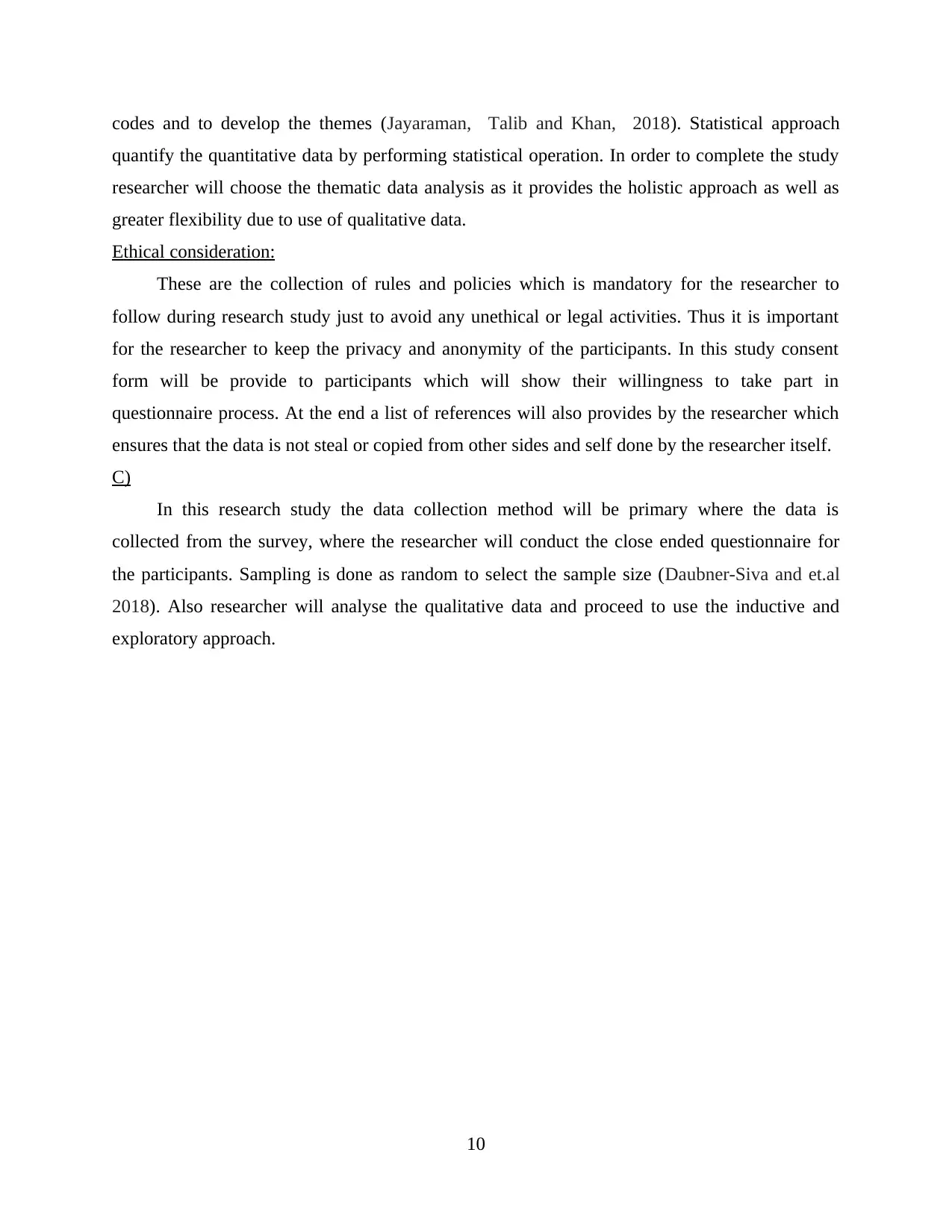
codes and to develop the themes (Jayaraman, Talib and Khan, 2018). Statistical approach
quantify the quantitative data by performing statistical operation. In order to complete the study
researcher will choose the thematic data analysis as it provides the holistic approach as well as
greater flexibility due to use of qualitative data.
Ethical consideration:
These are the collection of rules and policies which is mandatory for the researcher to
follow during research study just to avoid any unethical or legal activities. Thus it is important
for the researcher to keep the privacy and anonymity of the participants. In this study consent
form will be provide to participants which will show their willingness to take part in
questionnaire process. At the end a list of references will also provides by the researcher which
ensures that the data is not steal or copied from other sides and self done by the researcher itself.
C)
In this research study the data collection method will be primary where the data is
collected from the survey, where the researcher will conduct the close ended questionnaire for
the participants. Sampling is done as random to select the sample size (Daubner-Siva and et.al
2018). Also researcher will analyse the qualitative data and proceed to use the inductive and
exploratory approach.
10
quantify the quantitative data by performing statistical operation. In order to complete the study
researcher will choose the thematic data analysis as it provides the holistic approach as well as
greater flexibility due to use of qualitative data.
Ethical consideration:
These are the collection of rules and policies which is mandatory for the researcher to
follow during research study just to avoid any unethical or legal activities. Thus it is important
for the researcher to keep the privacy and anonymity of the participants. In this study consent
form will be provide to participants which will show their willingness to take part in
questionnaire process. At the end a list of references will also provides by the researcher which
ensures that the data is not steal or copied from other sides and self done by the researcher itself.
C)
In this research study the data collection method will be primary where the data is
collected from the survey, where the researcher will conduct the close ended questionnaire for
the participants. Sampling is done as random to select the sample size (Daubner-Siva and et.al
2018). Also researcher will analyse the qualitative data and proceed to use the inductive and
exploratory approach.
10
Paraphrase This Document
Need a fresh take? Get an instant paraphrase of this document with our AI Paraphraser
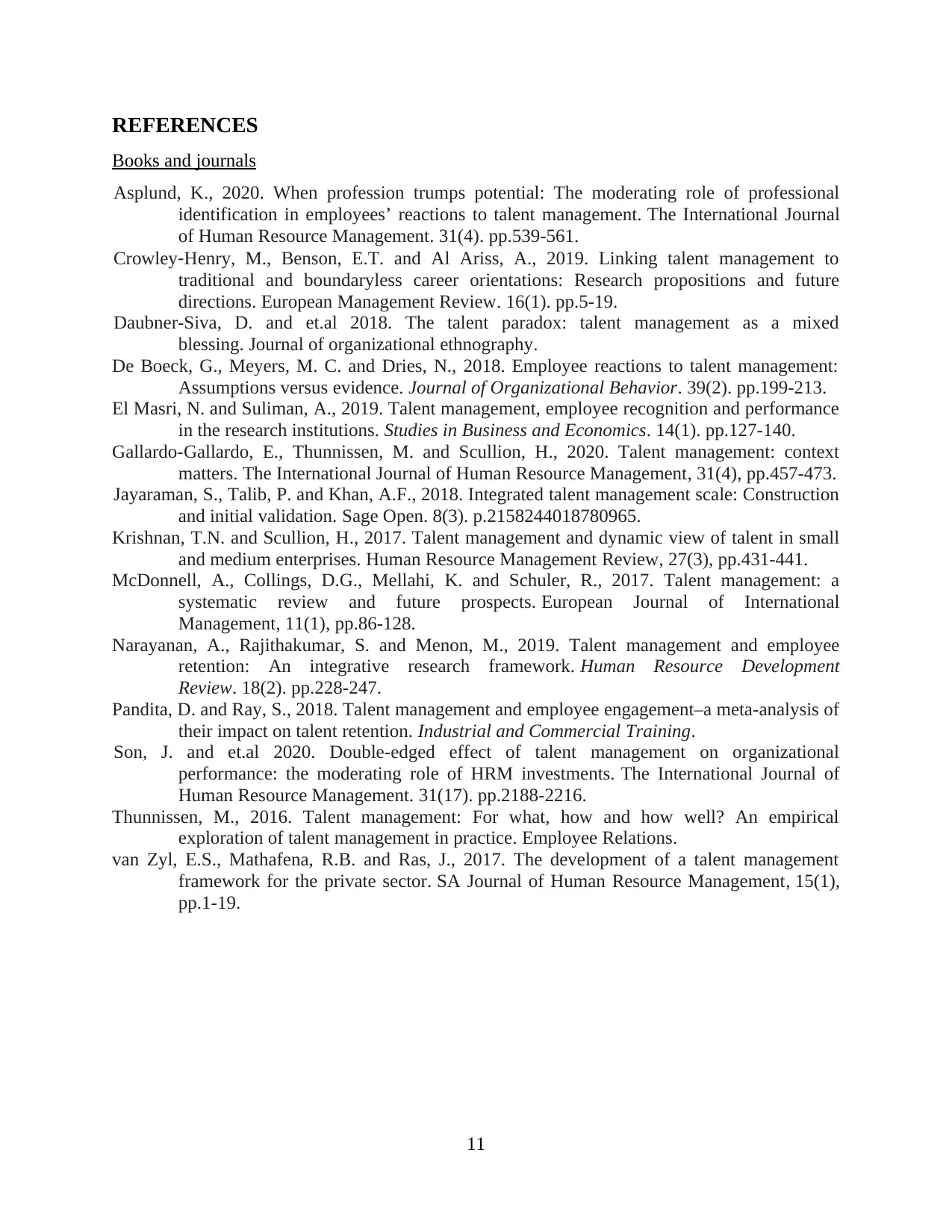
REFERENCES
Books and journals
Asplund, K., 2020. When profession trumps potential: The moderating role of professional
identification in employees’ reactions to talent management. The International Journal
of Human Resource Management. 31(4). pp.539-561.
Crowley‐Henry, M., Benson, E.T. and Al Ariss, A., 2019. Linking talent management to
traditional and boundaryless career orientations: Research propositions and future
directions. European Management Review. 16(1). pp.5-19.
Daubner-Siva, D. and et.al 2018. The talent paradox: talent management as a mixed
blessing. Journal of organizational ethnography.
De Boeck, G., Meyers, M. C. and Dries, N., 2018. Employee reactions to talent management:
Assumptions versus evidence. Journal of Organizational Behavior. 39(2). pp.199-213.
El Masri, N. and Suliman, A., 2019. Talent management, employee recognition and performance
in the research institutions. Studies in Business and Economics. 14(1). pp.127-140.
Gallardo-Gallardo, E., Thunnissen, M. and Scullion, H., 2020. Talent management: context
matters. The International Journal of Human Resource Management, 31(4), pp.457-473.
Jayaraman, S., Talib, P. and Khan, A.F., 2018. Integrated talent management scale: Construction
and initial validation. Sage Open. 8(3). p.2158244018780965.
Krishnan, T.N. and Scullion, H., 2017. Talent management and dynamic view of talent in small
and medium enterprises. Human Resource Management Review, 27(3), pp.431-441.
McDonnell, A., Collings, D.G., Mellahi, K. and Schuler, R., 2017. Talent management: a
systematic review and future prospects. European Journal of International
Management, 11(1), pp.86-128.
Narayanan, A., Rajithakumar, S. and Menon, M., 2019. Talent management and employee
retention: An integrative research framework. Human Resource Development
Review. 18(2). pp.228-247.
Pandita, D. and Ray, S., 2018. Talent management and employee engagement–a meta-analysis of
their impact on talent retention. Industrial and Commercial Training.
Son, J. and et.al 2020. Double-edged effect of talent management on organizational
performance: the moderating role of HRM investments. The International Journal of
Human Resource Management. 31(17). pp.2188-2216.
Thunnissen, M., 2016. Talent management: For what, how and how well? An empirical
exploration of talent management in practice. Employee Relations.
van Zyl, E.S., Mathafena, R.B. and Ras, J., 2017. The development of a talent management
framework for the private sector. SA Journal of Human Resource Management, 15(1),
pp.1-19.
11
Books and journals
Asplund, K., 2020. When profession trumps potential: The moderating role of professional
identification in employees’ reactions to talent management. The International Journal
of Human Resource Management. 31(4). pp.539-561.
Crowley‐Henry, M., Benson, E.T. and Al Ariss, A., 2019. Linking talent management to
traditional and boundaryless career orientations: Research propositions and future
directions. European Management Review. 16(1). pp.5-19.
Daubner-Siva, D. and et.al 2018. The talent paradox: talent management as a mixed
blessing. Journal of organizational ethnography.
De Boeck, G., Meyers, M. C. and Dries, N., 2018. Employee reactions to talent management:
Assumptions versus evidence. Journal of Organizational Behavior. 39(2). pp.199-213.
El Masri, N. and Suliman, A., 2019. Talent management, employee recognition and performance
in the research institutions. Studies in Business and Economics. 14(1). pp.127-140.
Gallardo-Gallardo, E., Thunnissen, M. and Scullion, H., 2020. Talent management: context
matters. The International Journal of Human Resource Management, 31(4), pp.457-473.
Jayaraman, S., Talib, P. and Khan, A.F., 2018. Integrated talent management scale: Construction
and initial validation. Sage Open. 8(3). p.2158244018780965.
Krishnan, T.N. and Scullion, H., 2017. Talent management and dynamic view of talent in small
and medium enterprises. Human Resource Management Review, 27(3), pp.431-441.
McDonnell, A., Collings, D.G., Mellahi, K. and Schuler, R., 2017. Talent management: a
systematic review and future prospects. European Journal of International
Management, 11(1), pp.86-128.
Narayanan, A., Rajithakumar, S. and Menon, M., 2019. Talent management and employee
retention: An integrative research framework. Human Resource Development
Review. 18(2). pp.228-247.
Pandita, D. and Ray, S., 2018. Talent management and employee engagement–a meta-analysis of
their impact on talent retention. Industrial and Commercial Training.
Son, J. and et.al 2020. Double-edged effect of talent management on organizational
performance: the moderating role of HRM investments. The International Journal of
Human Resource Management. 31(17). pp.2188-2216.
Thunnissen, M., 2016. Talent management: For what, how and how well? An empirical
exploration of talent management in practice. Employee Relations.
van Zyl, E.S., Mathafena, R.B. and Ras, J., 2017. The development of a talent management
framework for the private sector. SA Journal of Human Resource Management, 15(1),
pp.1-19.
11
1 out of 11
Related Documents
Your All-in-One AI-Powered Toolkit for Academic Success.
+13062052269
info@desklib.com
Available 24*7 on WhatsApp / Email
![[object Object]](/_next/static/media/star-bottom.7253800d.svg)
Unlock your academic potential
Copyright © 2020–2025 A2Z Services. All Rights Reserved. Developed and managed by ZUCOL.





